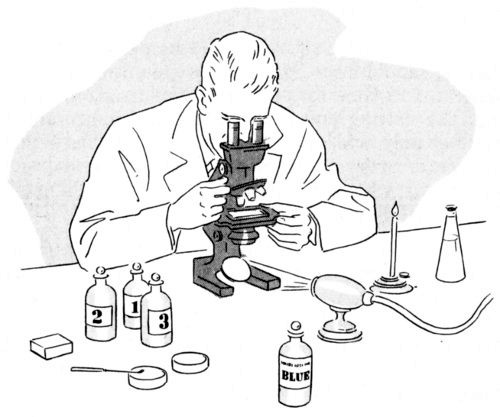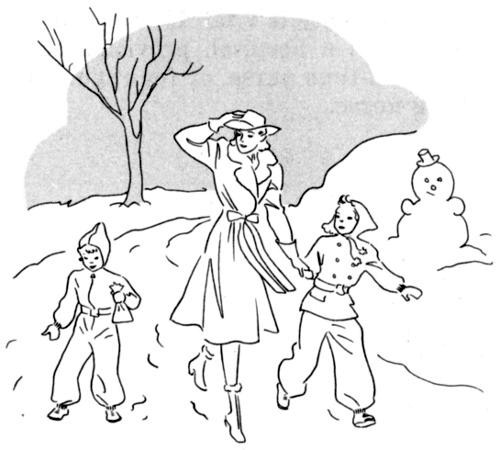

PNEUMONIA
Its care and
prevention
Copyright, 1940
John Hancock Mutual Life Insurance Company
of Boston, Massachusetts
L63-9-40
Life Conservation Service
of the
JOHN HANCOCK MUTUAL LIFE
INSURANCE COMPANY
of Boston, Massachusetts
An Urgent Message:
If you suspect that someone in your family has pneumonia, it is vital that you call your doctor without a moment’s delay. If it is pneumonia, hours will count. Newly introduced drugs have proved of great value in curing pneumonia but early medical treatment and prompt nursing care are necessary if the new treatment is to do the most good.
That you may know something about pneumonia, the kind of medical treatment and nursing care required, and the ways by which the disease may be prevented, this pamphlet is sent to you.
Life Conservation Service
of the
John Hancock Mutual Life
Insurance Company
of Boston, Massachusetts
Pneumonia is an inflammation of the lungs. Despite all the progress recently made in the treatment of the disease, it remains among the most common causes of death. Pneumonia is always a serious matter, and should be regarded as an emergency calling for immediate medical care.
The inflammation of the lungs may be due to one of a number of different kinds of germ, but the bacteria known as pneumococci cause about four cases out of every five. There are several varieties, or types, of pneumococci and the treatment may vary with the type. Your doctor has at his command some new drugs[A] but for some types of pneumonia he may combine the drug with a curative serum.
[A] The different members of this new family of drugs, sulfanilamide, sulfapyridine, sulfathiazol, etc. are used depending upon the nature of the pneumonia.
If the inflammation is due to one of the various other germs that cause the remaining fifth of the pneumonia cases, still other treatment may be needed. It is clear, then, that your physician should be called promptly when pneumonia is suspected so that he may have the laboratory tests made that will tell him with what kind of germ infection he[4] has to deal. Then he can decide what kind of treatment to employ.
Pneumonia appears to be spread from person to person by contact, so it is regarded as a communicable disease. As it is contagious, the spread of infection can be stopped if precautions are taken to prevent the transfer of the infectious material from the sick to the well. The secretions from the nose and throat of persons sick with pneumonia, or convalescing from the disease, usually carry the germs that cause it. The transfer may take place through direct contact with these secretions, or inhaling droplets of moist sputum expelled by the sick person while coughing or sneezing.
Pneumonia is no respecter of persons. It may attack tiny babies, adults in the prime of life, or elderly people: so everyone must be on guard. This is especially true in late winter and early spring when the disease is most likely to occur.
Pneumonia often begins during or just after an attack of the common cold, grippe, whooping cough, or measles, and after surgical operations, especially those upon the chest. In other conditions, such as unusual and prolonged fatigue or exposure to bad weather resulting in a thorough chilling, the chance of infection is increased.
In most cases of pneumonia the disease is readily recognized. There is often a preceding cold, but the onset of the pneumonia is usually abrupt, with sharp pain in the side, fever, a cough, a sense of chilliness or evident chills, and the expectoration of sputum streaked, or tinged, with blood.

Immediate medical and nursing care are vital in pneumonia.
If you should ever have any of these early signs of pneumonia, get promptly into bed and stay there.[6] Have your doctor called without a moment’s delay. You will improve your chance of a quick recovery if you give him the opportunity to determine the cause of your infection before it is many hours old. Remember: the longer the disease exists before treatment is begun, the more difficult it may prove to cure.
The exact cause of the inflammation can be determined only by a laboratory examination of specimens of sputum or blood. Fortunately, in most sections of the country, diagnostic services are now readily available.
The kind of germ is determined earliest by examining specimens of sputum.[B] Though the patient may have some difficulty in raising sputum, enough for laboratory needs can almost always be obtained if its importance is explained to him. The expectorated material should come from the lungs, and should be as free as possible from mixture with saliva and nasal secretions. The sputum can be collected in any clean, wide-mouthed bottle, or a cardboard sputum box, and sent without delay to the nearest laboratory. Within a short time a report is returned to your doctor advising him of the[7] findings of the examination. If pneumococci have been found, the special type will be named.
[B] Blood specimens are also of importance in diagnosis of the disease and determining the course of treatment.

Laboratories are now equipped to make prompt and reliable examinations of sputum specimens.
The new drugs which have been found so successful in curing pneumonia occasionally make the patient nauseated and uncomfortable for a time. The curative serums which are used for certain[8] types of pneumonia, also may sometimes produce unpleasant reactions temporarily. With both treatments it is essential that the patient be watched over by alert attendants at all times. Hence many doctors prefer that the pneumonia patient be taken to the hospital as soon as he becomes sick so that he can have the benefit of constant nursing care and so that everything possible may be done to avoid unpleasant reactions or allay the symptoms if they should occur.
If the patient must remain at home it is evident that he should have the best possible nursing care. When a full-time nurse is not to be in attendance, then the visiting nurse should be called in promptly. She not only will give the care to the patient that the doctor orders but will instruct the members of the family who must attend to the patient’s needs during her absence.
In addition to receiving the treatment already discussed, it is essential that the patient’s position in bed be changed at intervals to relieve congestion and increase comfort. From lying on his back he may be moved to one side or the other, but this, too, must be done for him. So, it is evident that constant care is vitally needed.
The doctor’s orders must be followed to the last detail. Nothing is unimportant. The nurse will[9] assist the attendants in following instructions. She will teach them what to observe in the patient’s condition, how to report the progress of the disease to the physician,[C] and will advise the members of the family how to prevent the spread of the patient’s infection to others in the household.
[C] The two booklets, “Home Care of Communicable Diseases” and “Caring for the Sick in the Home,” will prove useful as supplements to the nurse’s instruction. They are free for the asking.
In general, it may be said that a good physical condition of the body lessens the chance of an attack of pneumonia. A sensible balance of rest and exercise to prevent undue fatigue, eating nutritious meals, and avoiding over-exposure and chilling, all may help. It is the part of wisdom to stay indoors with a cold, and in bed while there is fever, for your own benefit as well as to prevent giving your infection to others.[D] While suffering from colds, grippe, tonsillitis, and the like, care should be taken to avoid exposure to draughts and rapid chilling of the body when overheated.
[D] “Living the Healthy Life” tells how to keep fit. “What to Eat and Why” discusses the question of diet. “That Mean Cold” tells more in detail about the care of colds. Copies of all these booklets will be sent to anyone on request.
Overcrowding greatly increases the chance of spreading pneumonia from person to person. When colds and other respiratory diseases are prevalent, public gatherings should be avoided as much as possible. Rules of health departments forbidding spitting should be strictly obeyed by all. Special precautions should be taken against unnecessary contact with pneumonia patients and those recently recovered from the disease, who still may be carriers of the germ. This precaution is especially important for persons who are run down, or have some existing respiratory disease.
In the care of patients with pneumonia, the following precautions for the protection of others must be observed:
If the patient is treated at home, only those responsible for his care should be permitted in the sick-room.
The patient’s nasal discharges and sputum should be collected in pieces of cloth or soft paper and burned promptly. Droplet infection may be avoided by placing a piece of cloth or soft paper over the patient’s mouth when he coughs or sneezes, and this cloth or paper should be burned. Unnecessary contamination of bedding or clothing should be prevented.
The patient’s eating utensils, bedding, and linen should be scalded and washed in soap and hot water.
Dry sweeping or dusting of the sick-room should not be permitted; cleaning can be done safely only with a damp cloth.
After each time that care is given to the patient, the attendant should scrub her hands thoroughly.
Articles which cannot be washed should be thoroughly aired and exposed to sunlight out-of-doors for a day.

Dressed for the weather, outdoor exercise keeps the body fit.
Pneumonia may attack without warning, but often is preceded by a cold.
If chills, fever, pain in the chest, and sputum tinged with blood occur, it is a signal to get to bed promptly and have the doctor called immediately.
New drugs have proved to be of great benefit in treatment, but for certain types of pneumonia both drugs and serum may be needed.
Good nursing care is vital. If the patient is not to be treated in a hospital, provision should be made for a full-time nurse, or for regular care by the visiting nurse.
Life Conservation Service
of the

MUTUAL
Life Insurance Company
of Boston, Massachusetts
L63-9-40 Printed in U. S. A.
Transcriber’s Note:
Retained publication information from the printed edition: this eBook is public-domain in the country of publication.